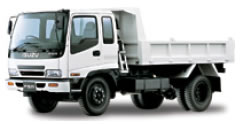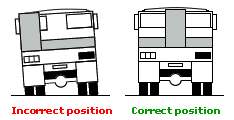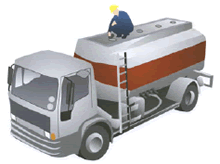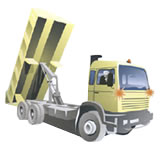An introduction programme for drivers of heavy motor vehicles.

A number of the items that must be checked during a daily inspection of a vehicle can directly affect the stability of that vehicle. Some of these are outlined below.
Tyres
Tyres transmit all the driving, braking, steering and cornering forces from the vehicle to the road. They also play a crucial role in maintaining stability. Tyres that are not inflated to the correct pressure will wear out much quicker. Research has shown that the life of a tyre that is consistently operated at a pressure 20 percent below what it should be can be reduced by at least 25 percent.
Tyres must be checked for compatibility, tread, inflation and damage at the commencement of the day or driving shift and spot checks of the tyres condition should be carried out during the shift. Tyre pressures should be checked with a gauge at least weekly.
Suspension
The suspension supports the entire vehicle's weight and isolates the vehicle and the load from road shocks.
While air suspension can provide superior stability and handling to traditional leaf springs, all suspension components must be checked for damage or distortion regularly.
Brakes and steering
These must be checked prior to moving off. Any problems that are found must be reported and immediately rectified.
Excessive ‘freeplay’ in the steering will result in difficulty maintaining a correct and proper driving line. As a general rule, any free movement at the rim of the steering wheel must not exceed 1/5 of the steering wheel's diameter. For example, for a steering wheel that has a diameter of 380 mm, the free play must not be more than 76 mm. If it has more than that, you should have it investigated immediately.
Hub temperatures can be checked as a way to identify whether individual brakes are binding or, alternatively, not operating at all. One brake out of adjustment can add metres to the stopping distance.
Load placement

Load placement and load security are key factors in vehicle handling and dynamics. Drivers must make sure there is enough weight over all axles to provide adequate brake balance, directional stability and to ensure individual axles are not overloaded.
It is recommended that at all times a heavy rigid vehicle has at least 20 percent of its gross mass on the front axle or twin-steer axle set of the vehicle. This gives the front wheels enough grip on the road to steer the vehicle.

Heavy rigid vehicles first registered on or after 1 July 2002 must have 20 percent of their mass on their front axle(s) at all times.
The load must be distributed evenly across the vehicle as shown below. When offloading freight, it's important to consider redistributing the remaining cargo to maintain the loads balance across the vehicle deck.
Heavy items should be placed to the bottom of the load so that the CG remains as low as possible.

Load transfer
When a vehicle is braking, the weight of the load is moved towards the front of the vehicle. This can increase the weight on the front axle, at the same time reducing the load on the rear axle(s). In severe braking applications the load on the rear axle may be removed almost completely and the vehicle will skid sideways, making the vehicle out of control. This may be particularly pronounced on wet or slippery roads or roads where the surface is not stable, such as on gravel.
It is for this reason that braking should always be smooth and steady and not aggressive.
There are a number of types of loads that require special consideration in regard to their stability. Some examples of these are listed below.
Tankers

Although there have been many improvements to tanker design over the years to improve their on-road stability, such as lowering the height of the tank, these types of vehicle still require special skills because of the nature of the freight they are transporting. A liquid in a tank will surge (move back and forward as the vehicle accelerates and slows down) so drivers of tankers must be constantly on their guard to ensure that this movement does not override their actions in controlling the vehicle. To overcome this problem some tankers (those that carry only a single product at a time) may be fitted with baffle plates to reduce the amount of surge, while tankers that carry a range of products in one load will have a series of self-contained compartments, effectively mini tanks inside a common shell.
Bulk dry goods
These types of vehicles often have an inherent high CG. The load can shift and, because of the nature of the load, once it has shifted it may not flow back to its original level.
Hanging meat
Meat hanging in a chiller body can be a very unstable load. Not only will the load have a high CG but the load can act like a pendulum and swing from side to side. This pendulum effect can be very noticeable on winding roads or when executing sharp turns at speed.
Livestock
Livestock can move around, even in approved stock crates. The effect of this can be reduced by keeping animals bunched together but even then the animals may lean over when the vehicle is going around a corner altering the CG.

Tip trucks
Particular attention must be paid to tip trucks, especially when they are being moved with the hoist up, such as when spreading road metal.
It is not uncommon for loads in tip trucks to stick to the sides of the dump body, causing a weight transfer to one side and when this happens the vehicle may tip over.